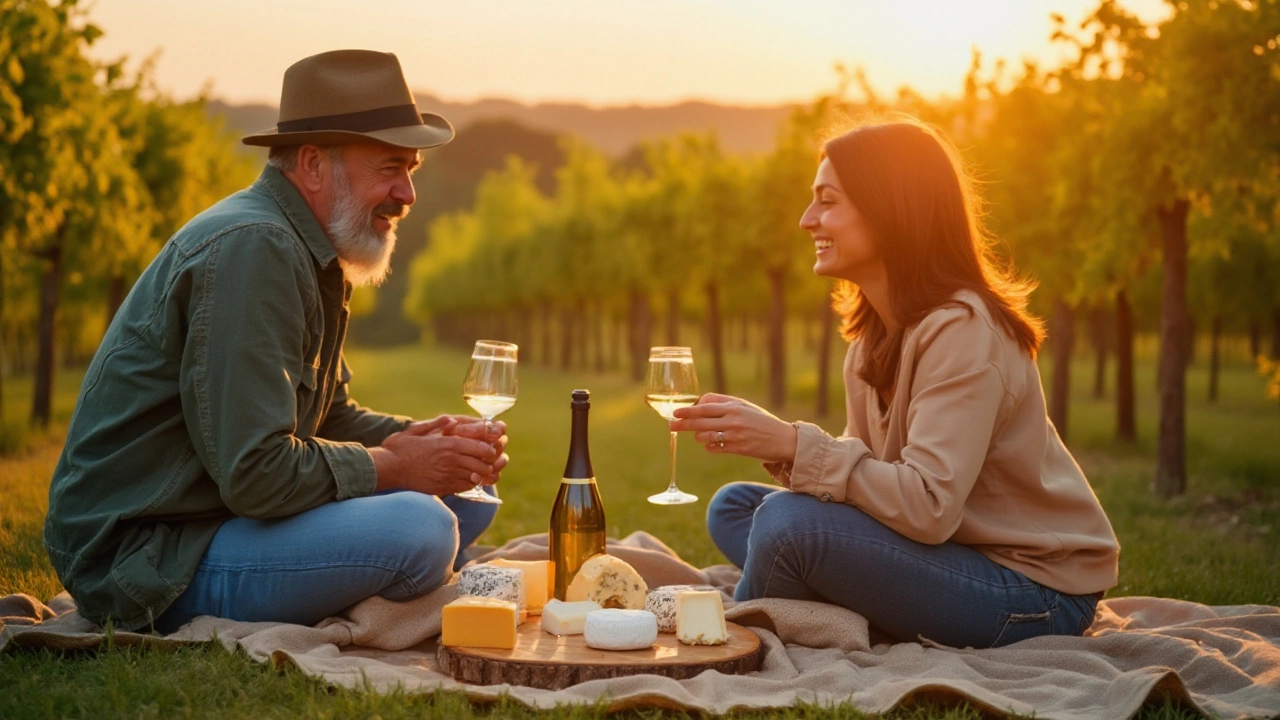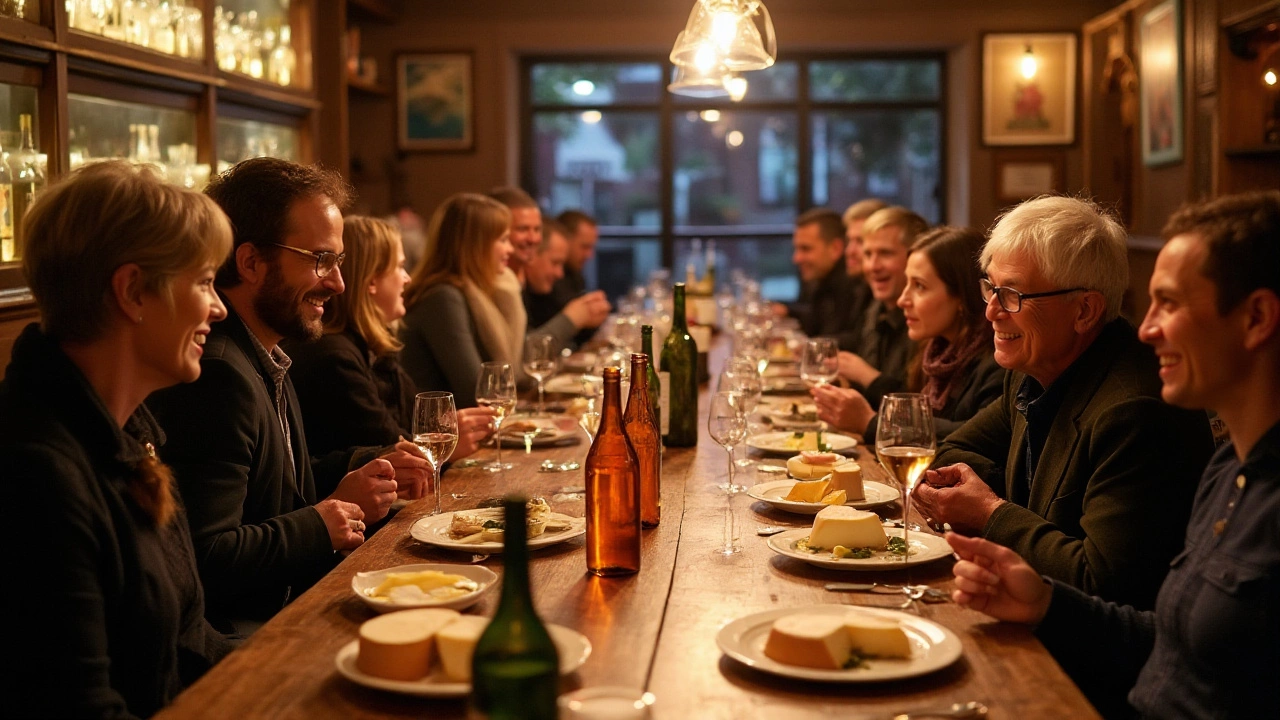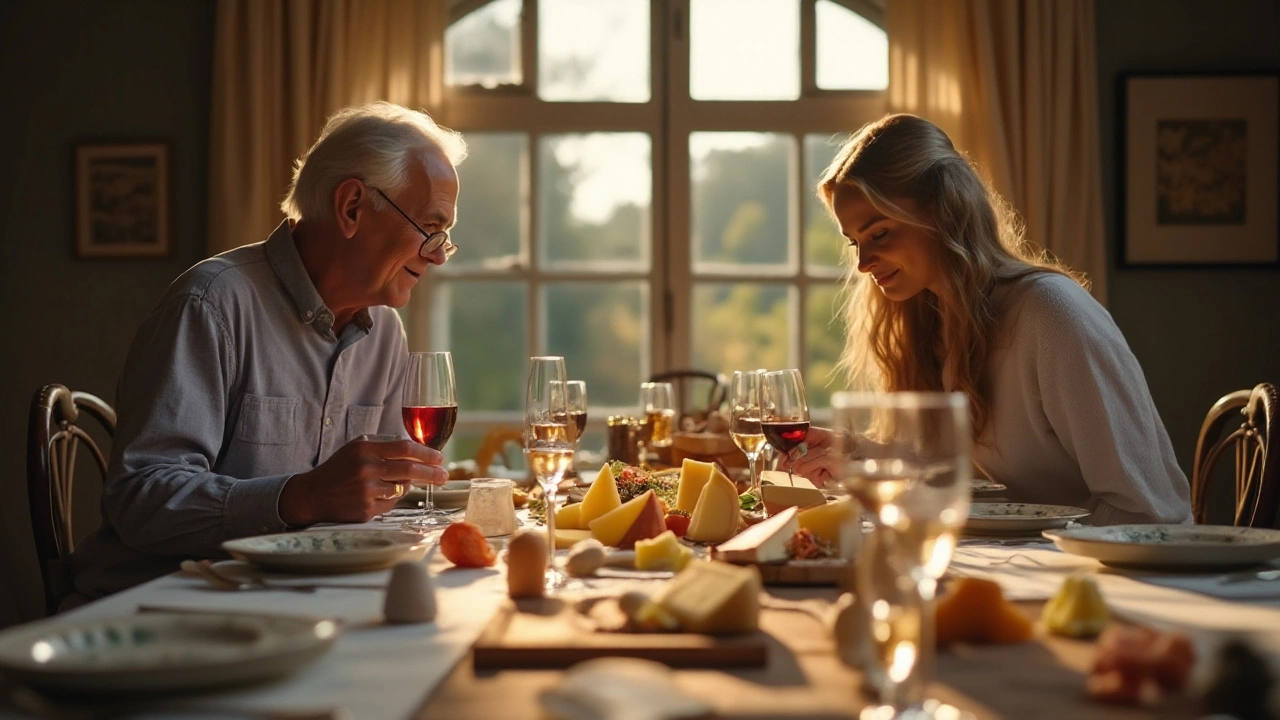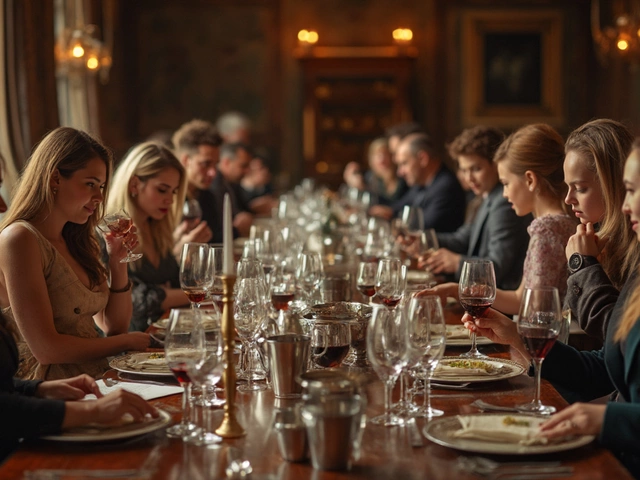There's something enchanting about the combination of wine and cheese—an age-old partnership that tantalizes taste buds around the world. Yet, one lingering question often arises: Should we dive into the cheese before sipping the wine, or savor the wine ahead of tasting the cheese? This seemingly simple choice can make a profound impact on the way flavors unfold on your palate.
This exploration is not merely about following a set of rules; it's more like unlocking a gateway to deeper enjoyment and appreciation of these gastronomic delights. Understanding how different textures and aromas merge and contrast can turn a casual tasting into an extraordinary sensory journey.
Whether you're exploring a bold Cabernet Sauvignon or a creamy Brie, knowing when to taste what opens the door to a mindfully delicious experience. Welcome to the dance of wine and cheese—a harmonious balance waiting to be brought to life.
- The Cultural Significance of Wine and Cheese
- A Matter of Preference: Cheese First or Wine First?
- Exploring Flavor Profiles: How They Influence Each Other
- Tips for a Successful Wine and Cheese Tasting
- Common Mistakes to Avoid in Pairing
The Cultural Significance of Wine and Cheese
Throughout history, the pairing of wine and cheese has transcended beyond mere culinary enjoyment to become a symbol of tradition, community, and even status. Originating from the bountiful vineyards and pastures of Europe, each region developed its distinctive pairings that reflected the unique qualities of local produce. Take France, for example, where the robust Roquefort cheese harmonizes with a lush Sauternes, or the creamy Brie that dances with a glass of Pinot Noir. In these cultures, wine and cheese were not just food items; they were expressions of local heritage and pride, sharing a story of the land and its people, evolving through hundreds of years of experimentation and experience.
These culturally entrenched ties are not confined to Europe alone. In Australia, burgeoning vineyards have started to carve out their own distinctive identity in the world of wine. Here, Australian producers experiment by pairing the native Shiraz with rich cheeses, which highlights the dynamic potential of this love affair between grape and curd. As the world becomes increasingly globalized, these traditional pairings start influencing culinary practices in different regions, intertwining local tastes with an international flair. This globalization broadens our collective palate, offering new opportunities to explore how diverse flavors interact.
"Wine and cheese speak the language of togetherness and conviviality," notes renowned wine critic Eric Asimov, emphasizing their role as facilitators of human connection.
Wine and cheese tastings have also become social rituals, occasions that bring people together in pursuit of sensory pleasure and enjoyment. It is a landscape where personal preference plays as much a role as objective quality. Within this interaction, there is a sense of exploration, guided largely by subjective experience, yet enriched by shared wisdom and tradition. Tasting events often double as educational experiences where participants learn about different varieties, ideal storage conditions, and intricate pairing principles that heighten the gastronomic journey. Moreover, studies suggest that millennials are reinvigorating this tradition; a study by the Australian Wine Research Institute indicates a significant rise in wine interest among young adults, showing a growing recognition of wine and cheese as part of the cultural zeitgeist.
As societies evolve, the way we pair wine and cheese evolves too, blending time-honored practices with inventive techniques. This evolution serves not only to preserve the cultural integrity of past generations but to also invigorate new engagements with these universally cherished foods. As you see, this iconic pairing serves as a bridge across cultures and time, connecting us to a storied past while inviting us to become a part of its future. Next time you sip a glass of wine alongside a slice of cheese, imagine the centuries of tradition echoing within that simple but eloquent act of savouring.
A Matter of Preference: Cheese First or Wine First?
When it comes to the art of wine and cheese pairing, the sequence of tasting can spark endless debates among enthusiasts. Some argue starting with cheese awakens the taste buds to appreciate the subtleties of wine, while others champion the opposite, suggesting that a wine’s bouquet should set the stage for cheese’s savory notes. There's no singular truth here—it's much like asking which came first, the chicken or the egg. Both perspectives offer unique experiences, each revealing different facets of the flavors involved.
Starting with cheese tasting often highlights the texture and creaminess of the cheese, creating a foundation upon which the wine can burst with flavor. The savory and sometimes salty attributes of cheese can amplify a wine’s sweetness or acidity, offering a contrast that enhances the tasting journey. For example, a nutty Gruyère might soften the tannins in a robust red, making it feel smoother to the palate. On the other hand, some prefer to begin with the wine to allow its aromas and flavors to prime the senses. A well-structured wine, with its layers of aroma, can elevate the cheese's distinct taste, releasing hidden nuances that may be otherwise overshadowed.
There’s something of a power dynamic at play; wines and cheeses have their unique personalities. How one approaches their tasting becomes a matter of which characteristic they wish to highlight first. According to cheese expert Madame Fromage, "Approaching cheese first allows it to assert its character, laying a creamy or tangy groundwork that compliments wine's intricate notes." This approach introduces a balanced harmony, almost like a symphony where each palate sensation plays a different instrument. Conversely, tasting wine first might make cheese appear as a pleasant afterthought, allowing the wine's initial impression to lay an aromatic base for the subsequent flavors.
Consider the type of wines and cheeses in your lineup. With softer cheeses like Brie or Camembert, some prefer to start with a sip of wine, believing its acidity can cleanse the palate and prepare it for a smooth texture. Harder, aged cheeses, such as Parmigiano-Reggiano, might benefit from tasting first, as they create a lingering umami that contrasts beautifully with a zesty white wine.
At its heart, this tasting sequence is a deeply personal choice, an opportunity to explore your palate and preferences. The joys of this pursuit lie in the versatility of flavor combinations, extending beyond conventional wisdom. Pairings are more art than science, evolving with every unique encounter—each tasting a dance between wine’s boldness and cheese’s indulgence, bringing satisfaction with every step.

Exploring Flavor Profiles: How They Influence Each Other
The magic of wine and cheese pairing lies in the intricate dance of flavors, textures, and aromas that create a symphony of taste on your palate. Each wine and cheese carries a unique profile, a signature blend of sweetness, acidity, bitterness, and umami. When paired correctly, these elements don't just coexist; they amplify one another, creating an entirely new sensation. Think about a robust red wine with its commanding tannins—when met with a creamy blue cheese, the cheese's fat can mellow the wine, revealing hidden fruity notes that elevate the experience. Suddenly, you're not just tasting two separate elements; you're experiencing a fusion.
Various factors contribute to this flavorful interaction. Take acidity in wine, for example. A bright, zesty white wine like Sauvignon Blanc can beautifully cut through the richness of a rich Camembert, cleansing the palate and preparing it for the next delightful bite. This refreshing quality is what makes tasting such pairings a rewarding journey of discovery. On the other hand, factors like tannin levels in reds or the saltiness in certain cheeses can contrast dynamically, creating a bold and memorable experience.
The texture is another layer that plays a significant role in cheese tasting. Imagine the luxurious mouthfeel of a Brie, with its decadence wrapped in a snowy rind. Pair it with a lighter-bodied wine, and witness how the cheese's creaminess accentuates the subtleties of the wine, weaving a tapestry of taste. The interaction isn't just about flavor; it's about texture, temperature, and harmony between what you sip and what you nibble.
"The art of pairing cheese and wine is one of creating harmony, where both the cheese and wine gain an extra dimension," explains fine dining expert and sommelier, Emily Borders.
To truly grasp this interaction, consider using a methodical approach. Start by analyzing the characteristic notes of your wine and cheese. Are you dealing with a sharp, tangy cheddar that could use the accompaniment of a sweet dessert wine like a Port? Or perhaps a spicy, aged Gouda that might pair nicely with a rich Zinfandel? These little observations carve the path for memorable pairings.
As these flavor profiles come together, the overall goal is balance. A too-strong wine might overpower a delicate cheese and vice versa. Each taste must complement the other, with no component overshadowing another. That way, you enjoy the full array of the wine's bouquet and the cheese's texture. Engaging in these pairing practices goes beyond mere consumption. It's about savoring, experimenting, and unlocking doors to new culinary adventures.
Tips for a Successful Wine and Cheese Tasting
Embarking on a wine and cheese tasting journey is as joyous as exploring uncharted territory. When done thoughtfully, it can open new realms of flavor, ushering you into a harmonious blend of tastes and aromas. The first step is to curate a variety of cheeses and wines that can serve specific purposes. Selection is key: picking both wine and cheese that complement each other, rather than competing, sets the stage for a delightful experience. Seek out an array of choices that span creamy blues to aged cheddars, and fresh goat cheese to rich, buttery Brie—an eclectic mix keeps the tasting vivid and captivating.
The environment in which you taste these delicacies also plays a pivotal role. Ideally, hosting an event in a setting where natural light abounds enhances your ability to appreciate the color and clarity of the wine. Glassware cannot be underestimated. Opt for clear, thin-rimmed glasses for the wine, which allow you to see the color, breathe in the aroma, and appreciate each sip's body. As for the cheese, wooden boards or marble platters can add to the aesthetic, while ensuring the cheese doesn't stick or alter its original temperature.
If we delve into temperature, precise attention should be paid here, too. Serving cheese at room temperature allows its flavors to shine, while wine finds its sweet spot when served slightly chilled. Red wines benefit from being slightly cooler than room temperature, while whites should be colder but not icy. Taking note of these details can profoundly impact your tasting experience. To guide you through this seamless experience, there's wisdom from Julia Child:
"Wine is meant to be enjoyed, with good company and good food, on a good day, or a bad day."Her words remind us that the human connection and mood are, in themselves, flavor enhancers, ensuring each pour and taste fosters joy.
Consider incorporating a bit of research into typical pairings known for their synergy. For instance, a robust red like Cabernet finds its match with aged cheddar, while a crisp Sauvignon Blanc flirtatiously complements soft goat cheeses. Understanding these traditional pairings permits exploration with intentionality, which can later be a springboard for creative concoctions, blazing new flavor pathways. Another handy tip is to start with lighter wines and cheeses, progressively working towards stronger ones. This approach ensures your palate isn't overwhelmed from the onset, allowing subtle tastes to be appreciated first, preserving the crescendo for the bolder duos.
Remember, wine isn't the sole companion to cheese on the culinary stage. Consider including accompaniments like fruits, nuts, or honey in your tasting spread. These elements can act as flavor bridges or conduits, adding still more depth and dimension to the tasting progression. When pairing, think about balance—sweet with savory, and mild with sharp, these combinations create synergy, elevating the entire taste profile.

Common Mistakes to Avoid in Pairing
Embarking on a journey through the world of wine and cheese pairing is a delightful endeavor, yet even the most enthusiastic gourmets can stumble into some common pitfalls. While there's an art and science to master, being aware of typical missteps ensures a more satisfying experience. One frequent blunder involves pairing intensely flavored cheeses with delicate wines or vice versa. When the strength of one overshadows the other, the harmony you seek is lost. For instance, pairing a potent blue cheese with a soft, subtle Pinot Grigio is likely to drown out the wine’s gentle notes. It’s crucial to strike a balance where the flavor profiles mesh, neither dominating the other.
Temperature plays a critical yet frequently overlooked role in tasting success. Wines served too warm can lose their refreshing qualities, while cheeses too cold might not release their full flavor potential. Have you ever tried savoring an ice-cold Brie? Not ideal. The experience transforms when cheese is allowed to warm to room temperature, unlocking its full aromatic potential, just as wine should be served at its appropriate temperature to capture the essence of its complexity.
Another slip-up is neglecting the texture element. Texture can impact the way flavors are perceived on your palate. Imagine the clash of a creamy goat cheese with a highly tannic Shiraz – the wine’s tannins can clash sharply with the cheese's creaminess, creating an overwhelming sensation, making both elements less enjoyable. Tasting an aged Gouda with a similarly robust wine creates a more balanced companion that complements each other instead of competing.
Cecilia Hedges, an acclaimed sommelier, wisely notes, "The dance between wine and cheese is like any other partnership: harmony through balance, an intricate interplay of flavors, textures, and aromas."
If you're hosting a tasting, it's essential to craft a narrative with your selections rather than throw wine and cheese together indiscriminately. This can be depicted through careful selection, rotating between hard and soft cheeses, alongside sweet, dry, or sparkling wines. Presenting varieties like a semi-hard cheese followed by a soft one juxtaposed against wines of increasing sweetness creates an ideal sensory journey.
Lastly, but perhaps most crucially, never rush the process. Savoring should be just that – a mindful experience. Allowing each element to rest on the tongue offers a deeper appreciation, revealing subtleties and nuances you might miss in haste. Appreciate the story within each sip of wine, every bite of cheese. With practice, avoiding these common hiccups will lead to a richer, more fulfilling wine tasting adventure.


